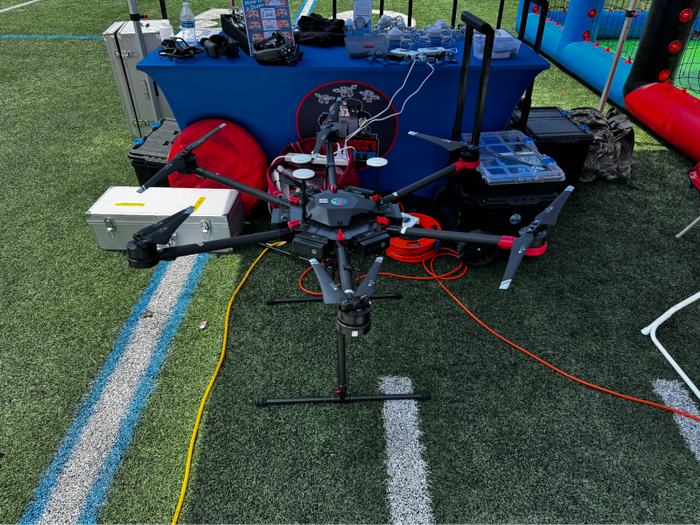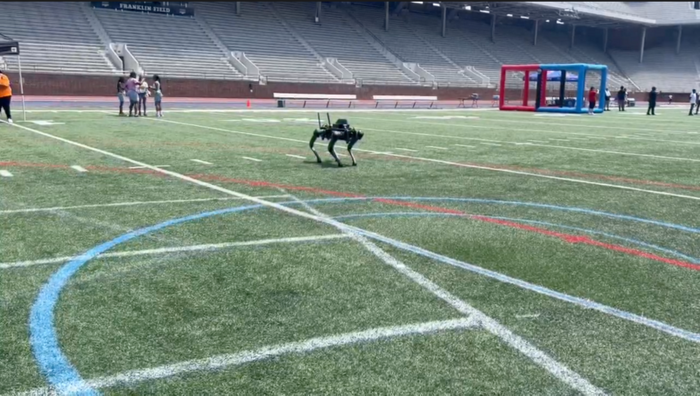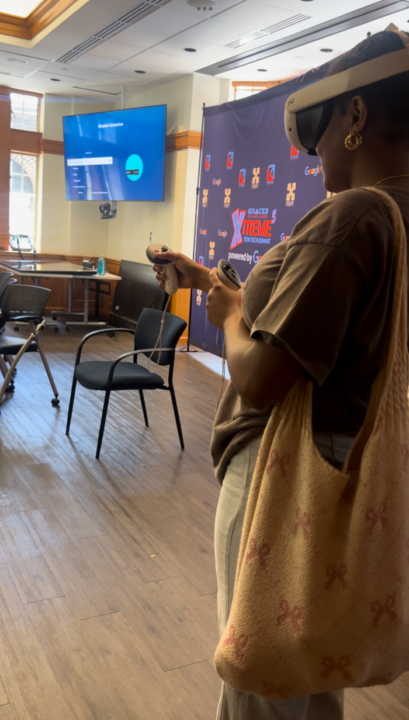
Teens flying a drone at the Grace3 Teen Tech Summit. Photo by Penn Graduate School of Education
There are many ways to try to beat the summer heat.
Some go see a movie. Others visit a water park.
But, for some, the best way to fight the summer heat is by learning about some cool technology inventions.
On Thursday, June 20th, 2024, Grace3 Technologies, Google, and the National Black Empowerment Council hosted the fourth annual Teen Tech Summit at Franklin Field to capture the imaginations of budding tech enthusiasts.
Booths representing different organizations lined the turf as fascinated students with awe-struck stares listened attentively to representatives explain their various gadgets and gizmos.
John Henry, chairman and CEO of Grace3 Technologies, created the summit.
“The intention behind the program I created was to provide advanced emerging technologies and STEM education to public school students in Philadelphia,” Henry said. “I bring all of my partners that I work with at my day job to this event. They share a common commitment to helping communities of color.”
One booth on the field belonged to Skydio, the largest drone manufacturer in the United States, whose drones are used by organizations such as the Army, Marine Corps, and New York Police Department.
At the booth, participants piloted a drone over the football field to learn about Skydio drones’ unique visual navigation that helps them avoid obstacles.

Along with assisting police in “overwatch” and “search and rescue”, the drones also provide advantages to help firefighters figure out where to direct streams of water during a fire, a Skydio representative said.
Because there are often hotspots within fires that can only be seen from the air, drones help firefighters have a more complete vision of the fire without having to leave the ground.
Unlike firefighters’ traditional approach of finding those hot spots using helicopters, which can be expensive and sometimes can’t reach certain locations, drones provide a more effective alternative thanks to their thermal cameras, according to the representative.
But their application doesn’t stop there.
The representative said parks departments can take advantage of drones’ ability to quickly search vast and hard-to-navigate areas and find missing people.
For bridge inspections, the representative said drones can be used instead of attaching people to cranes, decreasing cost and risk.
“Drones are going to be ubiquitous — if they’re not already — in the United States,” Henry said. “There’s a huge emerging market people of color can participate in.”
So, Henry said, he goes around the country trying to find opportunities to connect Black kids over age 15 with those emerging markets.
One way he said he does so is by training kids interested in earning their Part 107 drone pilot’s license. Henry said he works to find internships for kids with the license, so they can “have a career path that doesn’t require having to go to Harvard to make a livable wage.”
“Everyone knows how to play video games, flying a drone is exactly like playing a video game,” Marvel Joseph, a spokesperson for the Black Empowerment Council said.
Joseph urged the kids in attendance to take full advantage of the opportunities provided by their early access to technology and get their drone pilot’s license.
“With that license, you can become a pilot that can make close to $80,000 at the age of 18,” Joseph said. “When I was 18, I wasn’t making that kind of money.”
Like the Skydio drones, Verizon Frontline’s robot emergency dog — or “RED” for short — can also be used to quickly scan large areas.
Part of the Verizon Frontline Crisis Response Team, RED is mainly used as a platform for technical solutions, a representative said.
The representative said the team can equip RED with air monitors and send them in before first responders to let them know if an area’s safe to enter, along with what they might need to wear or bring with them.

Manufactured by the Ghost Robotics Corporation in Philadelphia for military and industrial use, REDs cost more than $200,000 to make and increase in price with additional features, like an articulating arm to open doors or a drone dock to integrate with a Skydio device, the representative said.
They said the 5G node on the top of RED allows first responders to bring cellular networks into areas that may not have them. The team can also put LiDAR detectors on RED to determine discrepancies in depths when responding to crises, according to the representative.
For example, if a floor collapses in a room, RED can use the LiDAR sensors to show first responders how the environment has changed, the representative said.
Henry said companies like Verizon and Google’s participation in the summit showed their commitment to providing low-income communities with access to emerging technologies.
“Verizon is an industry leader in first responders. Most of these kids didn’t know what a first responder does or who they are,” Henry said. “Emergencies happen all the time, but do people understand what goes behind that and how to keep people safe?”
After visiting RED and the Skydio drones on the field, the children were led inside, so they could participate in a virtual reality demonstration hosted by Level Up Philly, a holistic youth mentoring nonprofit organization based in West Philadelphia.
After recently receiving a $650,000 community expansion grant to build a computer lab in West Philadelphia, the organization showed off a new virtual reality headset.

At the station, kids were invited to put the headset on and go through brief virtual reality tours consisting of either a boxing experience or an experience exploring the human heart.
As someone who described himself as an “African American technology integrator,” Henry encouraged children to expose themselves to emerging technologies like virtual reality if they have access.
“If I was a child, if I was in middle school, I would go all in on technology,” Henry said. “These are twenty-first-century skills that aren’t going anywhere.”
He said partnerships with local organizations are crucial to providing children access to emerging technologies. Along with Level Up, Henry said he has formed partnerships with community-based organizations like the NoMO Foundation and the Police Athletic League of Philadelphia to help reach local kids.
“We — as a shared collaboration of business, industry leaders, and professionals — coalesce around these various summits every year exposing children to the technologies, otherwise they wouldn’t have (access to) it,” Henry said. “We’re exposing the kids, and not too many other people are doing that.”
As a Black man in an industry where that can be rare, Henry stressed the importance of diversifying his field. He said introducing Black children to emerging technologies is one way to help do so.
“In my business, there aren’t very many people who look like me,” Henry said. “That’s why I created this. These skills are going to be in high demand.”
Although he said being the only Black man in the room can make him feel isolated at times, Henry doesn’t let that deter him.
“You can run from it or you can try to change it,” Henry said. “We wanted to change it, (so) we created pipelines that make sense for our community and align with job demand.”
The results seem to be paying off already. This year, the summit expanded to multiple cities for the first time, according to Henry.
“We were in Chicago a week before the event (and) we were in Brooklyn back in March,” Henry said. “We intend to go to six other cities this year. That’s the model that we’re building.”
Henry said taking advantage of the opportunities provided at events like Thursday’s summit can help set kids on the path to success. He encouraged parents of interested students to look into after-school STEM programs.
“The more you know about cybersecurity, AI, coding, drones, autonomous vehicles, and the like, the greater likelihood of success you’re going to have to participate in the economy,” Henry said. “Our goal is to expose these technologies to African American, Black, and Brown communities first. I don’t know if all these companies are going to Beverly Hills and doing this, but they’re doing it in the communities that look like mine.”





